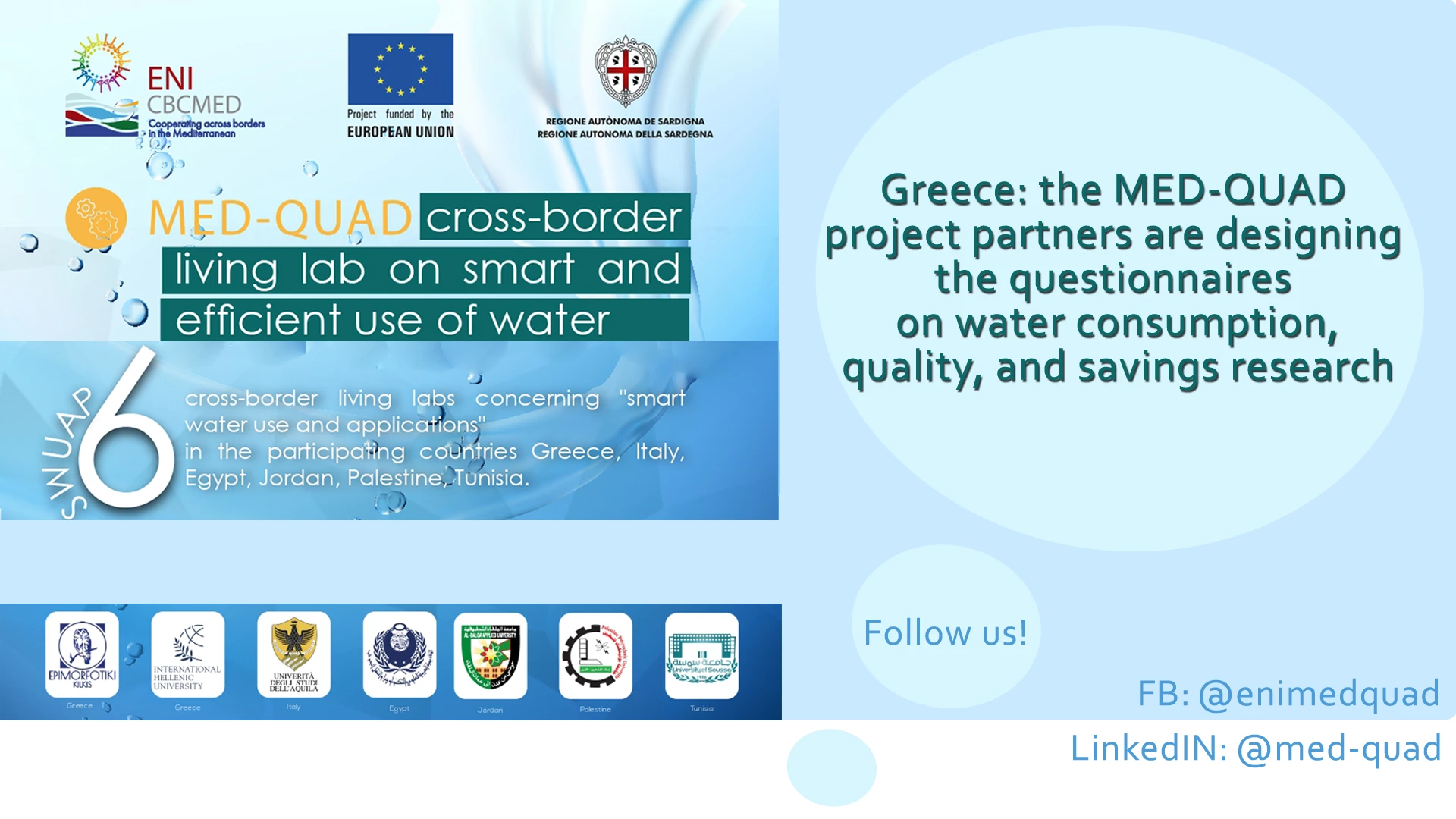"MEDiterranean Quadruple Helix Approach to Digitisation- MED-QUAD"
For more info about MED-Quad
The MED QUAD project refers to the "MEDiterranean Quadruple Helix Approach to Digitisation," focusing on digital innovation and collaboration across multiple sectors in the Mediterranean region. The "Quadruple Helix" model involves the collaboration of academia, industry, government, and civil society to foster innovation and sustainable development.Regarding water reuse, the MED QUAD project likely aims to address water scarcity and sustainability through digitization and innovative approaches. Here's how it might contribute to water reuse:
- Technological Innovation: The project may explore and develop advanced technologies for water treatment and recycling. This could involve the use of digital tools and smart systems for efficient water purification and reuse.
- Data Management and Analytics: Digital solutions can facilitate the collection, analysis, and management of water-related data. By leveraging digital platforms and analytics, the project can optimize water reuse strategies, ensuring proper treatment and safe reuse of wastewater.
- Stakeholder Collaboration: Involving various stakeholders (academia, government, industry, and communities) allows for diverse perspectives and expertise. Collaboration can lead to the development of comprehensive strategies for implementing water reuse practices effectively and sustainably.
- Policy Development: The project might contribute to policy frameworks that support and encourage water reuse initiatives. Digitalization can aid in monitoring compliance, improving regulations, and incentivizing businesses to adopt eco-friendly water reuse practices.
- Awareness and Education: Engaging civil society through digital mediums can raise awareness about the importance of water conservation and reuse. Education campaigns via digital platforms can encourage behavioral changes to support sustainable water practices.
Overall, the MED QUAD project likely employs digital innovation, collaboration, and policy development to create a more sustainable approach to water reuse, addressing challenges related to water scarcity and promoting responsible water management practices in the Mediterranean region.The Arab Academy for Science, Technology & Maritime Transport (AASTMT) contributed to the MED QUAD project in various capacities due to its focus on scientific research, technology, and its maritime expertise though
- Research and Innovation: AASTMT contributed through its research capabilities, offering expertise in developing innovative solutions for water management and digitization relevant to the MED QUAD project's objectives.
- Academic Collaboration: AASTMT collaborated with other stakeholders within the MED QUAD project, such as universities, research institutions, and industry partners, to exchange knowledge, conduct joint research, and develop educational programs focused on digital innovation and water reuse
- Training and Capacity Building: AASTMT provided training programs or capacity-building initiatives related to digital technologies and water reuse practices, educating professionals and stakeholders involved in the MED QUAD project.
- Field Implementation: AASTMT participated in practical implementations or pilot projects related to water reuse and digitalization, applying research findings and technological innovations in real-world settings

G r e e n P o r t s Application of renewable energy technologies for green ports: Egyptian ports as a case study (2021-2022)
The project aims to: Estimate the annual quantity of ship emissions due to ship berthing at Egypt ports. Propose a Port Environmental Management Plan (PEMP) and Green Port Policies for Egypt ports. Present the most feasible solution (types of renewable energy sources) in terms of technical and economic aspects, able to prove the most effective reduction of CO2, and determine the obstacles and guidelines associated with ports use of renewable energy will be studied.
https://aast.edu/getData/pdf_retreivefileNew_open.php?unit=1206&filename=/mediafiles/1206/Document/151164.pdf
PVENVOLPNZEB Innovative Photovoltaics Envelopes for Adaptive Energy and Comfort Management of Harsh Climate Areas in Upper Egypt Toward Nearly Zero Energy Buildings (2021-2022)
The main objectives of the present project are to: 1. Energy-saving is the main concern worldwide. This system will have a profound impact by generating fair jobs and increasing the productivity of electricity and reduce the thermal load of the building consequently the energy consumption. 2. The system will allow managing energy efficiently and will promote good practices in Egypt. 3. Improving the quality and extending the durability of the indoor air quality and thermal comfort. 4. To improve the thermal comfort of the glazing façade by sustaining the existing building with a novel shading system.
https://aast.edu/getData/pdf_retreivefileNew_open.php?unit=1206&filename=/mediafiles/1206/Document/151165.pdf
Campus Smart Recycling System to Turn Food Organic Wastes and Recyclables into Economic Value Products (2021-2022)
The main objective is managing and controlling the campus waste. 2. Adding an economic value to the organic food wastes instead of dumping it. 3. Reducing the campus running cost by: • Producing percentage of the campus disposable plastic tableware using AASTMT owned plastic injection machine reside at ISC. • Reducing the campus budget for purchasing: o Fertilizers used in campus cultivated areas. o Recyclables restaurant tableware (Spoons and forks). o Aluminum raw materials for student’s graduation projects.
https://aast.edu/en/scientific-research/projects/project.php?uid=16&proj_id=29
https://aast.edu/getData/pdf_retreivefileNew_open.php?unit=1206&filename=/mediafiles/1206/Document/151166.pdf
Blue Carbon Stock Assessment of Mangrove Forests along the Red Sea Coast of Egypt: Towards Climate Change Mitigation (2021-2022)
In light of the limited studies in the literature that connects the recent reliable estimates to carbon emissions and its relation to the mangroves in Egyptian Red Sea coast, the overall objective of this project is to facilitate development in the area, restore mangrove ecosystems, enhance ecosystem services (including carbon sequestration), promote sustainable mangrove related income, and act as a model for future projects

